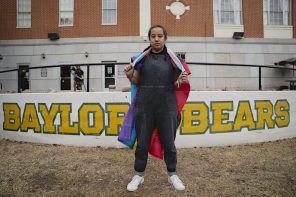“I think this whole category is the elephant in the room.”
That’s what Justice Stephen Breyer said, referring to religion and religious exemptions from laws that ban discrimination against LGBTQ people, during arguments Tuesday at the Supreme Court.
Breyer’s exchange with Solicitor General Noel Francisco came as battle between religious exemptions and LGBT rights returned to the Court in the form of three cases involving employees fired for being gay or transgender.
These disputes, involving a gay skydiving instructor from New York, a gay county employee from Georgia, and a trans funeral home director from Michigan, turn on the interpretation of a provision of Title VII of the Civil Rights Act of 1964. The law provides that employers may not discriminate “because of” an employee’s or prospective employee’s “race, color, religion, sex, or national origin.” The fired employees are arguing that courts should interpret the word “sex” to include sexual orientation and gender identity; the employers maintain that this goes well beyond what Congress intended. Until 2017, all the federal appeals courts that had confronted this question had sided with employers.
Much thoughtful analysis has already gone into the technical questions that will likely drive the outcomes of these cases. Both sides marshalled their favorite methods of statutory interpretation, disagreeing sharply on how courts might determine whether an employer had discriminated within the meaning of Title VII.
Attorneys for the gay employees stressed that they were discriminated against when they were fired for their attraction to men, since they wouldn’t have met that fate had they been women who were attracted to men. And likewise, the attorney for the trans employee argued that she was fired for conduct that would have attracted no notice had she been assigned female, rather than male, sex at birth. The employers responded that these are not the appropriate comparisons. As their attorneys argued, they would have fired a person of either sex who was attracted to the same sex, or who had, as they put it, dressed as a member of the opposite sex, so their actions do not amount to discrimination “because of” sex.
There’s much to say about these arguments, including the question of whether the employers were saying, in effect, that it is acceptable to discriminate against LGBTQ people so long as they discriminate against all LGBTQ people. But for those interested in the intersection of law and religion, one of the most curious features of Tuesday’s arguments was the way in which religion was rarely mentioned, yet somehow never quite out of the picture.
Chief Justice John Roberts raised the question of religious liberty in the first set of arguments the Court heard, concerning the gay employees who were fired on account of their sexual orientation. More than twenty states have antidiscrimination laws that explicitly include sexual orientation and gender identity but also provide exemptions for persons who discriminate on the basis of religious beliefs. Enacting these laws required patient negotiation and careful compromise, the Chief Justice observed. How can the Court protect religious liberty in a nuanced way if its only choice is whether or not to read Title VII to encompass discrimination on the basis of sexual orientation?
Justice Breyer introduced hypotheticals about religion into both sets of arguments. Suppose that an employer objects neither to Catholics nor to Jews per se, he imagined, but is deeply opposed to interreligious marriage. If that employer fires a Catholic employee for marrying a Jew, how is that not discrimination on the basis of religion if the employer would not have fired the employee for marrying a Catholic? The same logic, Breyer suggested, applies here.
These exchanges are neither surprising nor particularly groundbreaking. As Justice Breyer rightly observed, religion was lurking just under the surface of Tuesday’s arguments. Many disputes in recent years have involved claims that employers who hold certain religious beliefs deserve exemptions from generally applicable laws, including nondiscrimination laws designed to protect LGBTQ people. The Court’s 2018 Masterpiece Cakeshop decision presented what seems to have become the paradigm for such cases: a shop owner’s religious beliefs pitted against LGBTQ citizens’ rights to equal treatment. The Court punted in Cakeshop, but, with some notable exceptions, most state courts confronting similar disputes have sided with LGBTQ patrons.
The cases argued Tuesday differed in several important respects. First, unlike the Cakeshop-style cases, the antidiscrimination statute at issue, Title VII, does not explicitly cover sexual orientation or gender identity. And only one of the three employers in Tuesday’s cases came close to claiming religious motivations: R.G. and G.R. Harris Funeral Homes, which fired Aimee Stephens when she announced to her colleagues that she would be transitioning to live as a woman. Owner Tom Rost is a “devout Christian,” a former deacon at his Baptist church, and claimed that he would have violated the tenets of his faith had he continued to employ Stephens. Even so, Rost and his company abandoned their formal religious liberty defense at an earlier stage of litigation.
But despite purporting not to be about religion, Tuesday’s cases attracted input from religious groups across the ideological spectrum. National evangelical associations and the U.S. Conference of Catholic Bishops filed amicus briefs on behalf of the employers, while progressive Muslim groups, Jewish groups, and liberal Protestant churches did so for the employees. As they did in Cakeshop and cases like it, the former trotted out visions of the coercion that they believe religious entities would be subject to if the Court were to read sexual orientation and gender identity into Title VII. The latter affirmed that their faith mandates that they recognize the inherent dignity of all people and seek to prohibit discrimination in a pluralistic public square.
The outcome of Tuesday’s cases is by no means certain. Advocates on both sides strove to attract Justice Neil Gorsuch, the likely swing vote. Starting his third term, Justice Gorsuch has established himself as a textualist in the mold of Antonin Scalia, the justice he replaced on the bench. Briefs filed by the employees and their supporters sought to argue that the text of Title VII includes sexual orientation and gender identity, even if legislators at the time may not have recognized it. (It was Justice Scalia who, in a Title VII case in 1998, observed that “statutory provisions often go beyond the principal evil to cover reasonably comparable evils, and it is ultimately the provisions of our laws rather than the principal concerns of our legislators by which we are governed.”)
On the other side, the employers and their supporters insisted that the Congress that enacted Title VII did not intend for the word “sex” to include sexual orientation and gender identity. They sought to bolster this argument by pointing out that subsequent Congresses tried and failed to amend Title VII to include LGBTQ people.
Sometime in the first half of 2020, amidst a campaign that has already featured the country’s first out candidate for the presidency, the Court will hand down rulings that may well decline to expand LGBTQ rights in the context of private-sector employment. It’s likely that the opinions will have little to say about religion, and Tuesday’s arguments only gingerly touched on a topic that evokes passion and pain on all sides. But whichever way the Court rules, it will not resolve the deep conflicts between conservative religious activism and LGBTQ rights that have divided the nation.





